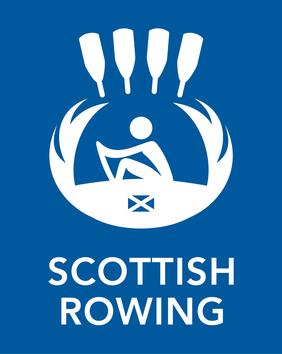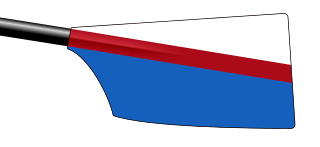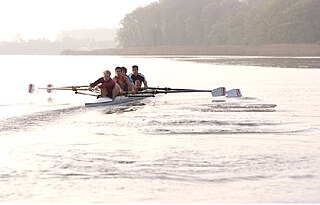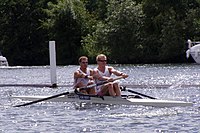
Rowing, often called crew in the United States, is the sport of racing boats using oars. It differs from paddling sports in that rowing oars are attached to the boat using rowlocks, while paddles are not connected to the boat. Rowing is divided into two disciplines: sculling and sweep rowing. In sculling, each rower holds two oars, one in each hand, while in sweep rowing each rower holds one oar with both hands. There are several boat classes in which athletes may compete, ranging from single sculls, occupied by one person, to shells with eight rowers and a coxswain, called eights. There are a wide variety of course types and formats of racing, but most elite and championship level racing is conducted on calm water courses 2 kilometres (1.2 mi) long with several lanes marked using buoys.
Lightweight is a weight class in combat sports and rowing.

The Wisconsin Badgers Crew is the rowing team that represents the University of Wisconsin–Madison. Rowing at the University dates back to 1874. The women's openweight team is an NCAA Division I team. The men's and lightweight women's programs compete at the Intercollegiate Rowing Association (IRA) Championship Regatta because the NCAA does not sanction a men's or lightweight women's national championship. Chris Clark has been the men's head coach since 1996 and Bebe Bryans was the women's head coach from 2004-2023.

The United States Rowing Association, commonly known as USRowing, is the national governing body for the sport of Rowing in the United States. It serves to promote the sport on all levels of competition, including the selection and training of those athletes who represent the US at international level.

Rowing has been part of the Summer Olympics since its debut in the 1900 Games. Rowing was on the program at the 1896 Summer Olympics but was cancelled due to bad weather. Only men were allowed to compete until the women's events were introduced at the 1976 Summer Olympics in Montreal which gave national federations the incentive to support women's events and catalysed growth in women's rowing. Lightweight rowing events were introduced to the games in 1996. Qualifying for the rowing events is under the jurisdiction of the World Rowing Federation. World Rowing predates the modern Olympics and was the first international sport federation to join the modern Olympic movement.

Rowing is the oldest intercollegiate sport in the United States. The first intercollegiate race was a contest between Yale and Harvard in 1852. In the 2018–19 school year, there were 2,340 male and 7,294 female collegiate rowers in Divisions I, II and III, according to the NCAA. The sport has grown since the first NCAA statistics were compiled for the 1981–82 school year, which reflected 2,053 male and 1,187 female collegiate rowers in the three divisions. Some concern has been raised that some recent female numbers are inflated by non-competing novices.

Scottish Rowing (SR), formerly the Scottish Amateur Rowing Association, is the governing body for the sport of rowing in Scotland. It is responsible for promoting the sport in Scotland and also for selecting crews to send to the Home International Regatta and the Commonwealth Rowing Championships. In addition, Scottish Rowing also runs three of the major regattas of the year, Strathclyde Park Regatta, the Scottish Rowing Championships and the Scottish Indoor Rowing Championships.

The Detroit Boat Club was established in 1839, as a sport rowing club. It was first created on the Detroit River during a time in which Detroit was just starting to grow. The Detroit Boat Club is a member of the Detroit Regional Yacht-racing Association (DRYA).

In a rowing crew, the coxswain is the member who does not row but steers the boat and faces forward, towards the bow. The coxswain is responsible for steering the boat and coordinating the power and rhythm of the rowers. In some capacities, the coxswain is responsible for implementing the training regimen or race plan. Most coaches cannot communicate to boat/coxswain, so the coxswain is the "coach" in the boat. A coxswain is necessary in the first place because the rowers sit with their backs to the direction of travel.
The Marin Rowing Association, located in Greenbrae, California, US is a rowing association and non-profit organization founded in 1968 by Coach R.C. "Bob" Cumming.
The Intercollegiate Rowing Association (IRA) governs intercollegiate rowing between varsity men's heavyweight, men's lightweight, and women's lightweight rowing programs across the United States, while the NCAA fulfills this role for women's open weight rowing. It is the direct successor to the Rowing Association of American Colleges, the first collegiate athletic organization in the United States, which operated from 1870–1894.

Durham University Boat Club (DUBC) is the rowing club of Durham University. In recent years, DUBC has cemented itself as one of the strongest university boat clubs in Great Britain. Under the leadership of former British Olympian Wade Hall-Craggs, DUBC notably won the BUCS Victor Ludorum for ten consecutive years (2004-2013), and has produced a number of athletes that have competed internationally at European and World Championship level.

Caryn Davies is an American rower. She is the winner of the 2023 Thomas Keller Medal, the most prestigious international award in the sport of rowing, and the only American to have ever won this award. She won gold medals as the stroke seat of the U.S. women's eight at the 2012 Summer Olympics and the 2008 Summer Olympics. In April 2015 Davies stroked Oxford University to victory in the first ever women's Oxford/Cambridge boat race held on the same stretch of the river Thames in London where the men's Oxford/Cambridge race has been held since 1829. She was the most highly decorated Olympian to take part in either [men's or women's] race. In 2012 Davies was ranked number 4 in the world by the International Rowing Federation. At the 2004 Olympic Games she won a silver medal in the women's eight. Davies has won more Olympic medals than any other U.S. oarswoman. The 2008 U.S. women's eight, of which she was a part, was named FISA crew of the year. Davies is from Ithaca, New York, where she graduated from Ithaca High School, and rowed with the Cascadilla Boat Club. Davies was on the Radcliffe College (Harvard) Crew Team and was a member on Radcliffe's 2003 NCAA champion Varsity 8, and overall team champion. In 2013, she was a visiting student at Pembroke College, Oxford, where she stroked the college men's eight to a victory in both Torpids and the Oxford University Summer Eights races. In 2013–14 Davies took up Polynesian outrigger canoeing in Hawaii, winning the State novice championship and placing 4th in the long-distance race na-wahine-o-ke-kai with her team from the Outrigger Canoe Club. In 2013, she was inducted into the New York Athletic Club Hall of Fame and in 2022 into the Harvard University Athletics Hall of Fame.

A coxless four, abbreviated as a 4- and also called a straight four, is a racing shell used in the sport of competitive rowing. It is designed for four persons who propel the boat with sweep oars, without a coxswain.

The College Boat Club of the University of Pennsylvania is the rowing program for University of Pennsylvania Rowing, which is located in the Burk-Bergman Boathouse at #11 Boathouse Row on the historic Boathouse Row of Philadelphia, Pennsylvania. Its membership consists entirely of past and present rowers of the University of Pennsylvania.

The Oxford University Women's Lightweight Rowing Club was established in 1984 to represent the University of Oxford in the race against the Cambridge University Boat Club at the Lightweight Boat Races. Throughout the season, the Club races as Tethys Boat Club.
The United States National Women’s Rowing Team is a select group of elite female athletes who represent the United States in international rowing competitions. The team first competed at the Olympics in 1976 and has had a multitude of successes. The implementation of Title IX during the 1970s had a large and positive impact on women’s collegiate rowing, and allowed for a growth in interest and talent in order for the creation of the national team. The team is selected through a competitive, in-depth process that is facilitated by USRowing each year. Tom Terhaar served as the national women’s head coach from 2001 until fall of 2021, and was a large part of the team's success in the past decade. The team’s eight (8+) won the gold medal at every summer Olympics between 2004 and 2016, finishing fourth at the 2021 Olympics. The US women's crew won every World Rowing Championships from 2005 through 2016.

The Lightweight Boat Races are a series of annual rowing races between men's and women's lightweight crews representing the University of Oxford and the University of Cambridge.

The rowing competitions at the 2024 Summer Olympics in Paris are scheduled to run from 27 July to 3 August at the Stade nautique de Vaires-sur-Marne, National Olympic Nautical Stadium of Île-de-France in Vaires-sur-Marne. The number of rowers competing across fourteen gender-based categories at these Games has been reduced from 526 to 502, with an equal distribution between men’s and women’s events. Despite the slight changes in athlete figures, the rowing program for Paris 2024 remains constant from the previous edition as the competition will feature an equal number of categories for men and women, with seven each.















